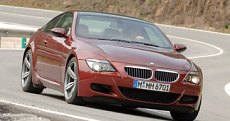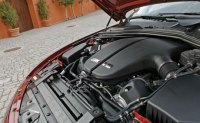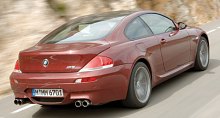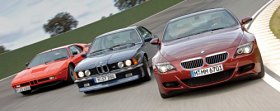|
BMW 6-Series (E63)
Debut: 2004
Maker: BMW
Predecessor: 6-Series E24
|
|
 The
original BMW 6-Series was a beautiful coupe. Involving to drive,
comfortable
to ride and desirable to own, it was the symbol of BMW coupes.
Unfortunately,
in 1990 BMW replaced it with the 8-Series, which was bigger, bulkier,
more
expensive and less inspiring to drive. The 8-Series didn’t repeat the
sales
success of its predecessor and was killed early. Since then BMW have
not
produced any coupes beyond the 3-series coupe, what a pity. The
original BMW 6-Series was a beautiful coupe. Involving to drive,
comfortable
to ride and desirable to own, it was the symbol of BMW coupes.
Unfortunately,
in 1990 BMW replaced it with the 8-Series, which was bigger, bulkier,
more
expensive and less inspiring to drive. The 8-Series didn’t repeat the
sales
success of its predecessor and was killed early. Since then BMW have
not
produced any coupes beyond the 3-series coupe, what a pity.
In
late 2003, the 6-Series was reborn. It was derived from the 5-Series
platform
and componentry, having its own (shortened) chassis and clothed with
another
controversial design by Chris Bangle. Like the 5-Series, the chassis is
an aluminum-steel hybrid. In order to shift weight towards the rear to
benefit handling, the front chassis frames, engine-mounted sub-frame
and
bonnet are made of aluminum while the center to rear chassis is steel
monocoque.
Further weight saving is made by thermoplastic front fenders, composite
boot lid, aluminum doors and aluminum suspensions. Even installed with
a 4.4-litre V8, the new 645Ci is just 50kg heavier than the 3.5-litre
6-cylinder
M635CSi of the past. That’s impressive by today’s standard.
The
Bangle design is inevitably strange, but it is already more
conventional
than the 5-Series and Z4. Its smooth-flowing profile enables a low drag
coefficient of 0.29 and is easy to eyes. Although the headlamps and
grilles
still look odd, the 7-Series-style boot lid works much better in the
coupe
form and isn’t unlike the "whale tail" of 911 Turbo.
Inside,
the cabin of 6-Series has good style and good plastics, but not enough
leather and craftsmanship. Compare with Maserati 4200GT (its number 1
rival)
it appeals to be too mass producing. Space in the rear, however,
matches
the Maserati. People up to 5ft 9in won’t find their heads rubbing the
roof.
 The
6-Series range starts from 630Ci with the familiar 231hp 3.0 straight-6
to the 333hp 4.4-litre 645Ci. A 500hp M6 will top the range eventually,
but at the moment we can only talk about 645Ci. The BMW V8 is as
smooth,
willing and torquey as usual. With Valvetronic throttle control, it
drinks
surprisingly little petrol for what it delivers - 0 to 60mph in 5.4
seconds.
But it is too quiet in the coupe, perhaps BMW ought to remove some of
the
sound insulation to please those love exploiting the power of the V8.
Compare
with Maserati’s V8, it is too civilized, no matter in terms of sound,
throttle
response or explosiveness. Its flat torque curve encourages its driver
to be lazy. That means it is a nice motorway cruiser but a less
exciting
driving machine. The
6-Series range starts from 630Ci with the familiar 231hp 3.0 straight-6
to the 333hp 4.4-litre 645Ci. A 500hp M6 will top the range eventually,
but at the moment we can only talk about 645Ci. The BMW V8 is as
smooth,
willing and torquey as usual. With Valvetronic throttle control, it
drinks
surprisingly little petrol for what it delivers - 0 to 60mph in 5.4
seconds.
But it is too quiet in the coupe, perhaps BMW ought to remove some of
the
sound insulation to please those love exploiting the power of the V8.
Compare
with Maserati’s V8, it is too civilized, no matter in terms of sound,
throttle
response or explosiveness. Its flat torque curve encourages its driver
to be lazy. That means it is a nice motorway cruiser but a less
exciting
driving machine.
Yes,
the 6-Series intends to be a more civilized coupe. You can order a very
smooth ZF 6-speed automatic gearbox in the 6-series, a thing Maserati
drivers
can never dream of. If you want conventional driver involvement, BMW
still
provides a slick 6-speed manual and a SMG sequential-shift version of
the
manual.
The
standard suspensions setting provides a sounded balance between body
control
and ride quality, which isn’t a surprise considering BMW wants its mass
production coupe to suit the taste of most buyers. Optional active
anti-roll
bar (taken from 7-Series) gives it terrific cornering stability without
leading to more fun. Yes, the 6-Series understeers less than the
5-Series
and it steers with more feel. It has remarkable grip and brakes in the
tradition of German cars. But it doesn’t feel especially sporty or
involving
to drive. The engine noise and civilized power delivery is one reason
preventing
its driver from getting inspired, the lack of character is another
reason.
Like a late Toyota Supra Turbo versus Porsche 928GTS, it meets all the
objective requirements but eventually fails to inspire its driver
through
steering, throttle, noise and chassis reaction. Therefore, in my mind,
the original M635CSi is still the definitive BMW coupe.
|
| The
above report was last updated on 25 Feb
2004. All Rights Reserved. |
M6
|
 With
M5
entered production last year, naturally the next development is M6.
As 6-Series is derived from the 5-Series platform, M6 is also a
development from the M5. The same 507 horsepower V10 powers both
cars. What make difference is the packaging: the M6 is slightly
wider, 9 cm lower and 45 kg lighter. Well, the last one is not very
impressive indeed, considering the M6 lost 10 cm wheelbase, 2 rear
doors
and a proper rear seat. With
M5
entered production last year, naturally the next development is M6.
As 6-Series is derived from the 5-Series platform, M6 is also a
development from the M5. The same 507 horsepower V10 powers both
cars. What make difference is the packaging: the M6 is slightly
wider, 9 cm lower and 45 kg lighter. Well, the last one is not very
impressive indeed, considering the M6 lost 10 cm wheelbase, 2 rear
doors
and a proper rear seat.
 BMW told
us it tried very hard to reduce weight. Apart from the aluminum
bonnet, aluminum doors, thermoplastic front fends and composite boot
lid already found in the regular 6-Series, the M6 adopted very thin
forged aluminum wheels - each saves 1.8 kg - and a carbon-fiber roof
panel like M3 CSL. The latter saves just 4.5 kg, but its benefit to
center of gravity should not be ignored. Anyway, 45 kg lighter than
the M5 is not something you can applause, neither is the 1710 kg kerb
weight. BMW told
us it tried very hard to reduce weight. Apart from the aluminum
bonnet, aluminum doors, thermoplastic front fends and composite boot
lid already found in the regular 6-Series, the M6 adopted very thin
forged aluminum wheels - each saves 1.8 kg - and a carbon-fiber roof
panel like M3 CSL. The latter saves just 4.5 kg, but its benefit to
center of gravity should not be ignored. Anyway, 45 kg lighter than
the M5 is not something you can applause, neither is the 1710 kg kerb
weight.
One of the
reasons is the V10 engine. It's a source of magic as well as a cause
of overweight. At 240 kg, this engine is 3 times heavier than the
other BMW V10 engine (well, that engine was only sold to Frank
Williams). But by any standard 240 kg is not something in compliance
with BMW's over-advertised "Lightweight Concept". The fact
hurts: Porsche has a V10 that undercuts the M-Power by 26 kg yet
produces 100 more horsepower.
 This make
the M6 a strange thing. Its engine, suspension tuning and tires work
every bit like a sports car. But its size and weight says otherwise.
When you switch the power mode to P500, flick the suspension damping
and steering servo control to Sport mode and the gearbox to S6 mode,
floor down the throttle and the V10 screams crazily (and
addictively), pushing your neck hard on the headrest, storms to 60
mph in 4.5 seconds and 100 mph in something around 9.5 seconds. Oh my
God, this is the supercar territory ! well, M5 was already in the
supercar territory. This make
the M6 a strange thing. Its engine, suspension tuning and tires work
every bit like a sports car. But its size and weight says otherwise.
When you switch the power mode to P500, flick the suspension damping
and steering servo control to Sport mode and the gearbox to S6 mode,
floor down the throttle and the V10 screams crazily (and
addictively), pushing your neck hard on the headrest, storms to 60
mph in 4.5 seconds and 100 mph in something around 9.5 seconds. Oh my
God, this is the supercar territory ! well, M5 was already in the
supercar territory.
 Steer the
M6, it has the meaty feel and high accuracy like its saloon brother.
Just everything goes faster and harder. Thanks to the wider track and
lower center of gravity, it corners even faster than the M5. The
soft-compound Pirelli P-Zero Corsa tires - the same one as Ferrari
360 Stradale and 911 GT3 RS - provide incredible grip. The M6 has a
little understeer in default, but when you switch off DSC and apply
power to the rear wheels, it can drift cornering as beautifully as M5. Steer the
M6, it has the meaty feel and high accuracy like its saloon brother.
Just everything goes faster and harder. Thanks to the wider track and
lower center of gravity, it corners even faster than the M5. The
soft-compound Pirelli P-Zero Corsa tires - the same one as Ferrari
360 Stradale and 911 GT3 RS - provide incredible grip. The M6 has a
little understeer in default, but when you switch off DSC and apply
power to the rear wheels, it can drift cornering as beautifully as M5.
But the
advantage over M5 is too slim. At the same time you lost the proper
5-passenger
accommodation and you pay £80,000 for the M6 compare to the
M5's £65,000. Moreover, the M6 rides harder and harsher than
the saloon - itself was already too hardcore to some people.
 Ridiculously,
M6 is supposed to be a high-performance GT rather than a sports car.
But its suspensions - even with 3 modes of damping to choose from -
is even harder than pure sports cars like 911 and Noble M12. This
is partly blame to the stiff sidewall P-Zero Corsa tires, but mostly
because BMW tried to hide its size and weight by firmer suspension
setting. This means M6 is not a good companion for cross-country
trip. Ridiculously,
M6 is supposed to be a high-performance GT rather than a sports car.
But its suspensions - even with 3 modes of damping to choose from -
is even harder than pure sports cars like 911 and Noble M12. This
is partly blame to the stiff sidewall P-Zero Corsa tires, but mostly
because BMW tried to hide its size and weight by firmer suspension
setting. This means M6 is not a good companion for cross-country
trip.
 Fast
though it is, the car has a couple of problems prevent it from
matching real sports cars. The first one is lack of steering feel.
The second is a brake prone to fade after continuous hard use.
Ironically, both problems are succeeded from the M5 because they
share the same steering rack and brakes. Unfortunately, we cannot
forgive these in a car supposed to be sportier than M5. Fast
though it is, the car has a couple of problems prevent it from
matching real sports cars. The first one is lack of steering feel.
The second is a brake prone to fade after continuous hard use.
Ironically, both problems are succeeded from the M5 because they
share the same steering rack and brakes. Unfortunately, we cannot
forgive these in a car supposed to be sportier than M5.
So, what
is M6 ? it is neither a sports car nor a grand tourer. It is not as
sensible as M5, nor as charismatic as Porsche 911. More problematic is:
it is really expensive. You can buy a dedicated sports car like 911
Carrera S or even GT3 for less money.
 In fact, its predecessor
M635CSi had the same pricing problem. Back in 1986, M635CSi was sold
for £41,000,
more than the contemporary Porsche 911 Carrera by £10,000. But M635CSi
was not just about 286 fire-breathing horsepower. It was also a
beautifully-styled, elegantly-built, good riding and comfortable
4-seater coupe. It provided many things that traditional sports cars
and grand tourers lacked of. That's why M635CSi had become a classic,
the definitive BMW performance coupe. In fact, its predecessor
M635CSi had the same pricing problem. Back in 1986, M635CSi was sold
for £41,000,
more than the contemporary Porsche 911 Carrera by £10,000. But M635CSi
was not just about 286 fire-breathing horsepower. It was also a
beautifully-styled, elegantly-built, good riding and comfortable
4-seater coupe. It provided many things that traditional sports cars
and grand tourers lacked of. That's why M635CSi had become a classic,
the definitive BMW performance coupe.
The latest M6 has almost doubled the power from M635CSi, but it falls
into an identity crisis. Today the BMW top coupe is neither as fun to
drive as Porsche 911, nor as competent (the poor brakes, the lack of
feel), nor as comfortable to ride, nor as beautiful, and it still ask
for more money. That's the problem. |
| The
above report was last updated on 12 May
2005. All Rights Reserved. |
|
|
|
General remarks
|
645Ci
|
M6
|
|
Layout
|
Front-engined, RWD
|
Front-engined, RWD
|
|
Chassis
|
Steel monocoque + aluminum front structure
|
Steel monocoque + aluminum front structure |
|
Body
|
Steel, aluminum, plastic, composites
|
Steel, aluminum, plastic, composites |
|
| Length / width / height |
4820 / 1855
/ 1373 mm |
4871 / 1855
/ 1377 mm |
|
| Wheelbase |
2780 mm |
2781 mm |
|
Engine
|
V8, 90-degree
|
V10, 90-degree
|
|
Capacity
|
4398 cc
|
4999 cc |
|
Valve gears
|
DOHC 32 valves, DVVT, VVL (Valvetronic)
|
DOHC 40 valves, DVVT |
|
Induction
|
-
|
- |
|
Other engine features
|
-
|
-
|
|
Max power
|
333 hp
|
507 hp
|
|
Max torque
|
332 lbft
|
383 lbft
|
|
Transmission
|
6-speed automatic
|
7-speed automated manual |
|
Suspension layout
|
F: strut
R: multi-link
|
F: strut
R: multi-link |
|
Suspension features
|
Active anti-roll bar
|
Adaptive damping
|
|
Tyres front/rear
|
245/45WR18
|
F: 255/40ZR19
R: 285/35ZR19
|
|
Kerb weight
|
1620 kg
|
1710 kg
|
|
Top speed
|
155 mph (limited)
|
155 mph (limited) |
|
0-60 mph (sec)
|
5.4* / 5.3**
|
4.5 (c) / 4.7* / 4.1**
|
|
0-100 mph (sec)
|
13.2* / 13.4**
|
9.7* / 8.9**
|
|
| Performance
tested by: |
*Autocar,
**C&D
|
|
630i
|
650i
|
|
Layout
|
Front-engined, RWD
|
Front-engined, RWD
|
|
Chassis
|
Steel monocoque + aluminum front structure
|
Steel monocoque + aluminum front structure |
|
Body
|
Steel, aluminum, plastic, composites
|
Steel, aluminum, plastic, composites |
|
| Length / width / height |
4820 / 1855
/ 1374 mm |
4820 / 1855
/ 1374 mm |
|
| Wheelbase |
2780 mm |
2780 mm |
|
Engine
|
Inline-6
|
V8, 90-degree
|
|
Capacity
|
2996 cc
|
4799 cc |
|
Valve gears
|
DOHC 24 valves, DVVT
|
DOHC 32 valves, DVVT, VVL (Valvetronic)
|
|
Induction
|
-
|
VIM
|
|
Other engine features
|
DI
|
-
|
|
Max power
|
272 hp
|
367 hp
|
|
Max torque
|
236 lbft
|
361 lbft
|
|
Transmission
|
6-speed manual
|
6-speed manual |
|
Suspension layout
|
F: strut
R: multi-link
|
F: strut
R: multi-link |
|
Suspension features
|
-
|
Active anti-roll bar
|
|
Tyres front/rear
|
245/50WR17
|
245/45WR18
|
|
Kerb weight
|
1530 kg
|
1650 kg
|
|
Top speed
|
155 mph (limited)
|
155 mph (limited) |
|
0-60 mph (sec)
|
5.9 (c)
|
4.9 (c) / 5.0*
|
|
0-100 mph (sec)
|
-
|
12.3*
|
|
| Performance
tested by: |
*C&D
|
|
|